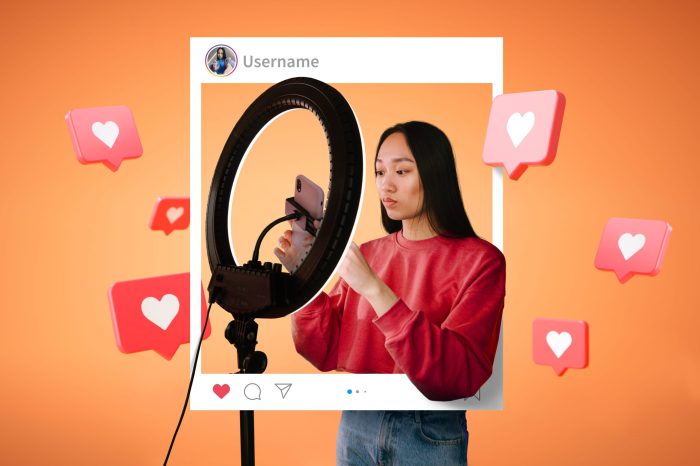Influencer Marketing Guide dives into the world of digital influence, shedding light on how brands can leverage influencers to skyrocket their online presence. From defining influencer marketing to exploring campaign strategies, this guide is your go-to resource for mastering the art of influencer collaboration.
Overview of Influencer Marketing
In today’s digital world, influencer marketing has become a powerful tool for brands to reach their target audience in a more authentic and engaging way. Influencer marketing involves collaborating with individuals who have a large following on social media platforms to promote products or services.Unlike traditional marketing strategies, influencer marketing focuses on building relationships with influencers who have already established trust and credibility with their followers.
This allows brands to tap into the influencer’s loyal fan base and leverage their influence to drive brand awareness, engagement, and ultimately, sales.
Yo, understanding consumer behavior is crucial in the game of business, ya know what I’m sayin’? It’s like peepin’ into the minds of customers, dig? By checkin’ out this dope article on Understanding Consumer Behavior , you can level up your marketing skills and stay ahead of the curve. So make sure you study up and stay woke, cuz knowledge is power, baby!
Examples of Successful Influencer Marketing Campaigns
- In the beauty industry, beauty brands like Kylie Cosmetics have successfully collaborated with beauty influencers like James Charles to promote new product launches, resulting in sold-out collections and increased brand visibility.
- In the fashion industry, luxury brands like Gucci have partnered with fashion influencers like Chiara Ferragni to create exclusive collaborations and limited-edition collections, driving hype and demand among fashion enthusiasts.
- In the fitness industry, supplement brands like Gymshark have worked with fitness influencers like Whitney Simmons to showcase their products in action, leading to increased sales and brand loyalty among fitness enthusiasts.
Types of Influencers: Influencer Marketing Guide

When it comes to influencers, there are various types that brands can collaborate with to reach their target audience. Each type has its own advantages and disadvantages, so it’s essential to understand the differences before deciding on a partnership.
Micro-Influencers
Micro-influencers have a smaller following, typically ranging from 1,000 to 100,000 followers. While they may not have the reach of macro or mega influencers, they often have a more engaged and loyal audience. Working with micro-influencers can help brands connect with niche markets and drive authentic engagement. An example of a brand that effectively collaborated with micro-influencers is Glossier, a beauty company that leveraged the power of micro-influencers to create buzz around their products.
Macro-Influencers
Macro-influencers have a larger following, usually between 100,000 to 1 million followers. They offer a broader reach and can help brands increase their visibility among a wider audience. However, working with macro-influencers can be more expensive, and their followers may not be as engaged as those of micro-influencers. An example of a brand that successfully partnered with macro-influencers is Adidas, which worked with popular athletes and celebrities to promote their products.
Yo, understanding consumer behavior is key when it comes to the biz game. It’s all about knowing what makes peeps tick and how they make decisions. Check out this dope link for more insights on Understanding Consumer Behavior.
Mega-Influencers
Mega-influencers have millions of followers and are often celebrities or well-known personalities. They have the potential to reach a massive audience and generate significant brand awareness. However, collaborating with mega-influencers can be extremely costly, and their endorsements may come across as less authentic. An example of a brand that has effectively collaborated with mega-influencers is Pepsi, which has worked with global superstars like Beyoncé to promote their products.
Finding the Right Influencers

In the world of influencer marketing, finding the perfect match for your brand is crucial for a successful campaign. Identifying the right influencers can make or break your marketing strategy.
Identifying the Right Influencers, Influencer Marketing Guide
When looking for influencers, it’s essential to consider factors such as their niche, audience demographics, engagement rates, and authenticity. Here are some key steps to help you find the right influencers for your brand:
- Define Your Goals: Clearly Artikel your campaign objectives and target audience to identify influencers who align with your brand values.
- Research Influencers: Use tools like Social Blade, BuzzSumo, or Upfluence to search for influencers within your niche and analyze their performance metrics.
- Audience Alignment: Ensure the influencer’s audience matches your target demographic to maximize the impact of your campaign.
- Engagement Evaluation: Look beyond the follower count and analyze the influencer’s engagement rate, comments, likes, and shares to gauge their authenticity.
- Content Quality: Review the influencer’s content style, quality, and tone to see if it resonates with your brand’s image and messaging.
Tools and Platforms for Finding Influencers
There are various tools and platforms available to help brands search for influencers efficiently. Some popular options include:
- Instagram Insights: Utilize Instagram’s built-in analytics tool to discover potential influencers based on audience demographics and engagement metrics.
- Influencer Marketing Platforms: Platforms like AspireIQ, Influencity, and Traackr provide databases of influencers, making it easier to find the right fit for your brand.
- Hashtag Research: Monitor relevant hashtags in your industry to identify influencers who are already talking about topics related to your brand.
Evaluating Influencer Authenticity and Engagement
Before collaborating with an influencer, it’s crucial to assess their authenticity and engagement levels. Here are some tips to help you evaluate influencers effectively:
- Audience Interaction: Check the influencer’s comments section to see how they engage with their followers and respond to queries.
- Follower Growth: Look for consistent and organic follower growth rather than sudden spikes, which could indicate fake followers.
- Content Relevance: Ensure that the influencer’s past collaborations align with your brand values and are relevant to your target audience.
- Audit Tools: Use tools like HypeAuditor or Social Blade to analyze an influencer’s audience quality, authenticity, and engagement metrics.
Influencer Marketing Campaign Strategies
Influencer marketing campaigns can be a powerful way to reach a target audience and drive engagement. By partnering with influencers who have a strong following and credibility in a specific niche, brands can effectively promote their products or services. Here’s how to create a successful influencer marketing campaign:
Steps for Creating a Successful Campaign
- Define Campaign Goals: Start by outlining the objectives of your campaign. Whether it’s increasing brand awareness, driving website traffic, or boosting sales, clearly define what you want to achieve.
- Identify Target Audience: Understand who your target audience is and choose influencers whose followers align with your ideal demographics.
- Research and Select Influencers: Look for influencers who have a genuine connection with their audience, high engagement rates, and a track record of successful brand partnerships.
- Create Authentic Content: Work with influencers to develop content that resonates with their followers while showcasing your brand in a natural and authentic way.
- Track and Measure Results: Use tracking tools and analytics to monitor the performance of your campaign and evaluate its impact on key metrics.
Budgeting Considerations and ROI Measurement
When budgeting for an influencer marketing campaign, consider factors such as the influencer’s reach and engagement rates, the complexity of the campaign, and any additional costs for content creation or sponsored posts. To measure ROI, track metrics like website traffic, social media impressions, click-through rates, and conversion rates to determine the effectiveness of your campaign.
Examples of Innovative Campaign Strategies
- Collaborating with Micro-Influencers: Partnering with micro-influencers with smaller but highly engaged audiences can lead to more authentic and impactful campaigns.
- Interactive Campaigns: Creating interactive experiences such as polls, quizzes, or challenges with influencers can boost engagement and drive user participation.
- Long-Term Partnerships: Building long-term relationships with influencers can result in ongoing brand advocacy and continuous exposure to their followers.
Legal and Ethical Considerations
In the world of influencer marketing, it’s crucial to be aware of the legal guidelines and ethical considerations that come into play when forming partnerships with influencers. Transparency and authenticity are key components in influencer collaborations, ensuring that both the influencer and the brand maintain credibility with their audience. Let’s dive into the importance of following these guidelines to stay compliant while running successful influencer campaigns.
Disclosure Requirements
When working with influencers, it’s essential to disclose any paid partnerships or sponsored content. The Federal Trade Commission (FTC) in the United States requires influencers to clearly disclose their relationship with a brand to their audience. This can be done by using hashtags like #ad, #sponsored, or #partner in social media posts. Failing to disclose these partnerships can lead to legal consequences and damage the trust of your audience.
Authenticity and Transparency
Authenticity is key in influencer marketing. Audiences are looking for genuine recommendations from influencers they trust. It’s important for influencers to only promote products or services that align with their personal brand and values. Brands should also give influencers the creative freedom to craft content that feels authentic to their audience. Transparency about partnerships and sponsorships builds trust with followers and ensures that the influencer’s recommendations are genuine.
Ensuring Compliance
To ensure compliance with regulations, both brands and influencers should stay up to date on the latest guidelines from regulatory bodies like the FTC. Brands should have clear contracts outlining disclosure requirements and ensuring that influencers understand their responsibilities. Regularly monitoring influencer content for compliance and providing guidance when needed is also crucial. By prioritizing transparency, authenticity, and compliance, brands and influencers can build strong, long-lasting partnerships that resonate with their audience.
Influencer Marketing Metrics and Measurement
Influencer marketing campaigns can be successful if the right metrics are used to measure their impact. Key performance indicators (KPIs) play a crucial role in assessing the effectiveness of influencer collaborations. Let’s dive into the essential metrics and methods for measuring the success of influencer campaigns.
Key Performance Indicators (KPIs)
- Engagement Rate: This metric measures the level of interaction (likes, comments, shares) between the influencer’s audience and the content posted.
- Reach: Indicates the number of unique users who have been exposed to the influencer’s content, providing insights into brand visibility.
- Conversion Rate: Tracks the percentage of users who took a desired action after engaging with the influencer’s content, such as making a purchase or signing up for a newsletter.
Tools and Methods for Tracking Metrics
- Social Media Analytics Platforms: Tools like Socialbakers, Hootsuite, or Sprout Social offer in-depth data analysis of influencer campaigns.
- UTM Parameters: Using unique tracking codes in URLs helps monitor traffic and conversions generated by specific influencer posts.
- Affiliate Links: Providing influencers with custom links allows brands to track sales directly attributed to their collaborations.
Case Studies
- Brand Awareness: A fashion brand saw a 30% increase in brand mentions and a 20% rise in followers after partnering with a popular fashion influencer.
- Engagement: A beauty company achieved a 50% boost in engagement rates on Instagram through a series of influencer-generated content.
- Sales: An e-commerce store experienced a 40% increase in sales attributed to an influencer’s promotion code shared with their audience.
